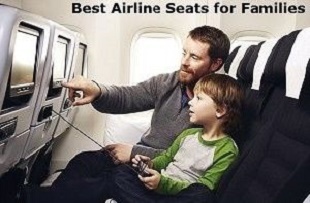AIRPLANE SEATING AREAS: It’s a common question asked by almost all parents flying with small children and babies.
But, naming the best airline seats for families with children has more than one simple answer.
This is partly because everyone has their own flight preferences. And, most budget airlines provide families with divergent seating arrangements.
But, all is not lost. You can decide what is best for your family by weighing up the pros and cons of the seating area guidelines explained in this section.
Bulkhead Seats
Airplane bulkhead seats directly face the partitions which divide the different sections of the aircraft. That means they have no seating facilities in front of them. Thus, there is often more leg room.
Bulkhead seating areas are usually found towards the front end on smaller airplanes. They also exist at several other locations on larger aircraft.
Another advantage for families choosing bulkhead seating is that the spot usually provides extra oxygen bags for babies and toddlers. This could be particularly handy if your baby is sitting on your lap.
Also, in-flight carrycots can usually be snapped on and attached to the bulkhead in front of you.
Some airlines allow you to reserve a carrycot, but you may need to phone ahead of time to make sure. Rental carrycots are usually a first-come, first-served basis. As a rule, they design them for babies weighing less than 12.5kg.
There are disadvantages of choosing the seating opposite a bulkhead or some aisle seats. You could find that the chair armrests rarely go up so you may struggle to stretch out.
Some aircraft have big television screens (not seatback). So, you may be disappointed to find a large screen or monitor directly above your head.
Another drawback is a distinct lack of space for family hand luggage underneath bulkhead seating areas. Some airlines allow hand luggage stowage by your feet in front of you. Whereas, other carriers may insist that your baggage gets placed in the overhead locker during the flight.
As a parent, you may find this a tiresome inconvenience if you travel with several children. You know they will be asking for a replenishment of toys and snacks on a regular basis.
 Sitting at the Rear
Sitting at the Rear
If you choose to sit towards the rear of the airplane you should consider that back row seats do not recline fully, as a rule.
Seating at the back of planes tends to be noisy because of the engine location.
Nonetheless, this may be blessing in disguise if your baby is also being louder than you would like.
Front Row Seating
Choosing one of the front row seats means you may get a speedier getaway after landing. Alternatively, sitting behind the wing usually provides a flight that is less bumpy if you have nervous children.
If you decide not to reserve a flight seat for your baby they are usually allowed to sit on your lap instead. The airline should provide you with a special safety strap. You should let the airline know in advance if you are flying with a baby because a rule there is a charge.
Seats at Emergency Exits
Families flying with small children, toddlers, or a baby are not usually offered the spacious seats near to emergency exits. For safety reasons, the vast majority of airlines do not allow the occupation of emergency exit seats by young or tiny travellers.
Child Car Seats and Buggies
Tip: Check with airline policies, but often they will allow you to take a baby car seat into the cabin.
You will need to have booked and paid for a separate seat in most cases if you take a car seat on board. Still, as a general rule, your baby will need to sit on your lap for take off and landing. This ruling also includes any time the ‘fasten seatbelt light’ gets activated (e.g. during turbulence).
This regulation changes when your child reaches two years old. All children must then have their own seat and cannot get secured on your lap during ‘fasten seatbelt’ times.
Many airlines also have security restrictions on baby food allowances and boarding procedures with milk for babies in your carry on luggage.
Advice on Airline Car Seat and Buggy Policies
- As a rule, car seats must have a 5 point harness with a rigid frame. The fixing should use the lap seat belt on the plane seat if they get taken on board.
- Depending on the airline, they will also need to be either EU or FAA approved.
- If you have a buggy, most reputable airlines allow you to take it up to the steps or entrance of the aeroplane.
- After landing, it will not be available to you until you have cleared passport control and baggage claims.

